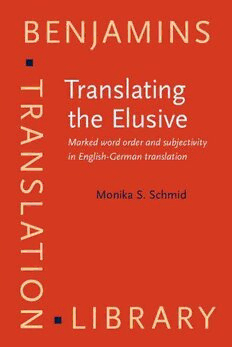
Translating the Elusive: Marked Word Order and Subjectivity in English-German Translation PDF
Preview Translating the Elusive: Marked Word Order and Subjectivity in English-German Translation
TRANSLATING THE ELUSIVE MARKED WORD ORDER AND SUBJECTIVITY IN ENGLISH-GERMAN TRANSLATION BENJAMINS TRANSLATION LIBRARY The Benjamins Translation Library aims to stimulate research and training in transla tion and interpreting studies. The Library provides a forum for a variety of approaches (which may sometimes be conflicting) in a socio-cultural, historical, theoretical, applied and pedagogical context. The Library includes scholarly works, reference works, post-graduate text books and readers in the English language. GENERAL EDITOR Gideon Toury {Tel Aviv University) ADVISORY BOARD Marilyn Gaddis Rose (Binghamton University) Yves Gambier (Turku University) Daniel Gile (Université Lumière Lyon 2 and ISIT, Paris) Ulrich Heid (University of Stuttgart) Eva Hung (Chinese University of Hong Kong) W. John Hutchins (University of East Anglia) Zuzana Jettmarovâ (Charles University of Prague) Werner Koller (Bergen University) Alet Kruger (UNISA) José Lambert (Catholic University of Leuven) Franz Pöchhacker (University of Vienna) Rosa Rabadán (University of León) Roda Roberts (University of Ottawa) Juan C. Sager (UMIST, Manchester) Miriam Shlesinger (Bar-Ilan University, Israel) Mary Snell-Hornby (University of Vienna) Sonja Tirkkonen-Condit (University of Joensuu) Lawrence Venuti (Temple University) Wolfram Wilss (University of Saarbrücken) Judith Woods worth (Mt. Saint Vincent University, Halifax) Sue Ellen Wright (Kent State University) Volume 36 Monika S. Schmid Translating the Elusive Marked word order and subjectivity in English-German translation TRANSLATING THE ELUSIVE MARKED WORD ORDER AND SUBJECTIVITY IN ENGLISH-GERMAN TRANSLATION MONIKA S. SCHMID Heinrich-Heine- Universität, Düsseldorf JOHN BENJAMINS PUBLISHING COMPANY AMSTERDAM/PHILADELPHIA The paper used in this publication meets the minimum requirements of Ameri can National Standard for Information Sciences — Permanence of Paper for Printed Library Materials, ANSI Z39.48-1984. Library of Congress Cataloging-in-Publication Data Schmid, Monika S. Translating the elusive : marked word order and subjectivity in English-German translation / Monika S. Schmid. p. cm. - (Benjamins translation library, ISSN 0929-7316 ; v. 36) Includes bibliographical references and indexes. 1. English language—Translating into German. 2. English language—Grammar, Compara tive-German. 3. German language-Grammar, Comparative-English. 4. English language- Word order. 5. German language—Word order. I. Title. II. Series. PE1498.2.G47 S34 1999 438'.0221-dc21 99-056683 ISBN 90 272 1641 X (Eur.) / 1 55619 795 0 (US) (alk. paper) © 1999 - John Bcnjamins B.V. No part of this book may be reproduced in any form, by print, photoprint, microfilm, or any other means, without written permission from the publisher. John Benjamins Publishing Co. • P.O.Box 75577 • 1070 AN Amsterdam • The Netherlands John Benjamins North America • P.O.Box 27519 • Philadelphia PA 19118-0519 • USA To Jenny, Robert, and the LAA Contents Abbreviations x Acknowledgment xi Introduction 1 CHAPTER 1. Notions of speaker attitude 6 1.1 Subjectivity 7 1.1.1 Traugott's theory of grammaticalization 8 1.1.1.1 Semantic bleaching 8 1.1.1.2 Pragmatic strengthening—modality 9 1.1.2 Lang acker's theory of subjectivity 11 1.1.2.1 Subjectification 13 1.1.2.2 Modality 16 1.2 Empathy 19 1.2.1 Kuno 's theory of empathy 20 1.2.2 Empathy and topicality 21 CHAPTER 2. Information structure 27 2.1 Functional approaches to word order 28 2.1.1 Theme—Rheme 28 2.1.2 Functional Sentence Perspective 30 2.1.3 The given/new distinction 32 2.1.4 Topic—Focus 36 2.2 Iconicity in Syntax 42 2.2.1 Marked Syntax 44 2.2.2 Marked Topics 46 VIII TRANSLATING THE ELUSIVE CHAPTER 3. Non-canonical word order 48 3.1 Inversion 50 3.1.1 Structure 50 3.1.2 Full inversion 52 3.1.2.1 The 'emotional' component 52 3.1.2.2 The presentative function 54 3.1.2.3 Information status 56 3.1.3 Subject-auxiliary inversion 60 3.2 Left dislocation and topicalization 62 3.2.1 Structure 62 3.2.2 Functions 63 3.2.2.1 Left dislocation 63 3.2.2.1.1 Information status 65 3.2.2.1.2 Topicality/persistence 67 3.2.2.2 Topicalization 70 3.3 Cleft sentences 71 3.3.1 Structure 71 3.3.2 A comparison of WH-clefts and it-clefts 74 33.3 Information status 77 3.3.3.1 WH-clefts 78 3.3.3.2 It-clefts 79 3.4 Subjectification and presupposition in marked sentence structures 83 CHAPTER 4. Translatability 87 4.1 Inversions 90 4.1.1 FI—the emotive component 90 4.1.2 FI—the pres entative function 94 4.1.3 SAI 100 4.2 Left dislocation 101 4.2.1 LD and topic management 102 4.2.2 Deictic LD 109 4.2.3 LD as a marker of foreigner-talk' 111 4.3 Topicalization 118 4.4 Cleft sentences 121 4.4.1 WH-clefts 122 CONTENTS IX 4.4.1.1 Information status and presupposition 122 4.4.2 Contrastive focus 127 4.4.2 It-clefts 132 4.4.2.1 Information status and presupposition 132 4.4.2.2 Exclusiveness 135 4.5 Synthesis 137 Conclusion 139 Notes 143 Texts 153 Bibliography 157 Subject Index 171 Author Index 173 Abbreviations AdjP adjective phrase CD Communicative Dynamism CWO canonical word order F free translation FI full inversion FSP Functional Sentence Perspective GAP gap LD left dislocation NP noun phrase OE Old English PDE Present Day English PROP proposition REF referent SAI subject-auxiliary inversion SP structure-preserving translation T translation as it was published in the German work VP verb phrase
